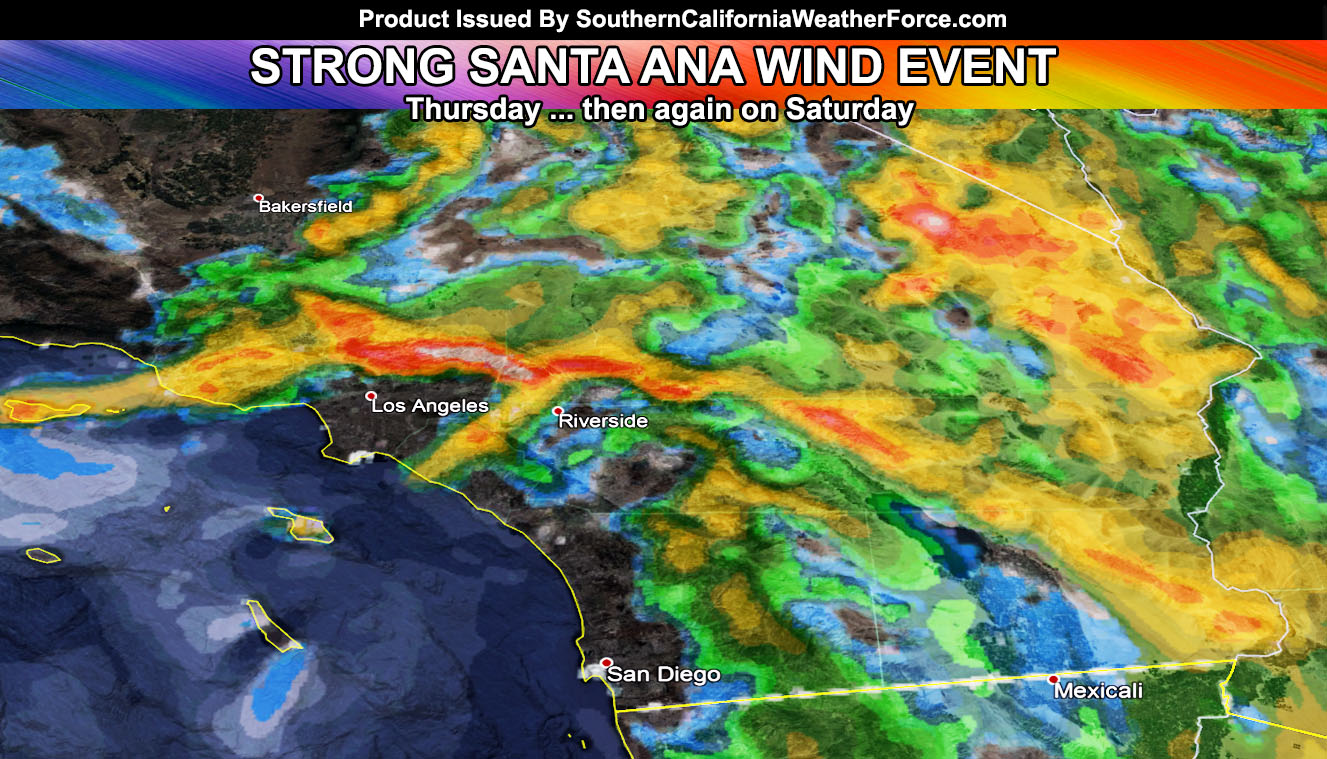A shortwave system moving around the ridge will move east of the forecast area, bringing with it strong gusty northerly winds on your Thursday, with the fire risk remaining high. The return of the Geminid Meteor Shower is tonight as well! Read on for details.
A cold system moving out of Canada through the Western United States will miss our forecast area to the east. However, as Thursday morning hits, this system will bring strong northerly winds with it. The winds have enough upper support to warrant them being strong across Santa Ana Wind Prone zones. The strongest winds of this northerly wind event will be out of the bottom of the Cajon Pass, where we could see winds in excess of 80 mph. High profile vehicles traveling through the warned zones will need to take extra precautions and/or cancel the trip.
If it does not say “Liked” LIKE The Page Below and join thousands of informed weather forecast viewers in our region for more of the updates!
If returning to the Ontario International Airport, expect the landing to be rough, with the outside chance that your airline may be diverted to Las Vegas if the pilots cannot land the plane. This happened a few times with the last Santa Ana Wind Event.
Other prone zones in the valleys will see 30-50 mph wind gusts.
Warm temperatures, Low Humidity Levels, and of course those gusty winds … will make for a high fire risk once again. Being these are northerly winds with no real easterly component… San Diego County will be mostly calm to breezy along I-15, with stronger gusts in the mountains.
Deserts: Because this has strong upper level dynamics reaching the ground, or upper support .. the low deserts from the Morongo Basin, Colorado River Valley, Coachella Valley, and even Imperial County will see the wind gusts as well … so you are also introduced in my Santa Ana Wind Warning on the main alert map.
There will be a break on Friday … however a stronger system on Saturday may re-introduce the strong Santa Ana Winds once again … More on that a bit later.
HATE THE ADS or Love the Forecasts and Want To Support The Work To Help it Stay? Become a premium member and support the service and receive forecast perks as well …
Click Here To Learn More …
After being washed out by the 2016 December supermoon, the Geminids will come roaring back in 2017. The famous and bright meteor shower will peak on overnight tonight (Dec. 13 and morning of Dec. 14).
The Geminids are considered one of the best meteor showers every year because the individual meteors are bright, and the peak can see meteors stream across the sky at rates as high as 120 meteors an hour. Under light-polluted skies, fewer meteors will be visible.
The Geminid meteor shower is nearly 200 years old, according to known records — the first recorded observation was in 1833 from a riverboat on the Mississippi River — and is still going strong. In fact, it’s growing stronger. That’s because Jupiter’s gravity has tugged the stream of particles from the shower’s source, the asteroid 3200 Phaethon, closer to Earth over the centuries.
The meteors tend to peak about 2 a.m. your local time wherever you’re observing from, but can be seen as early as 9-10 p.m.
The Geminids, as their name implies, appear to emanate from the bright constellation Gemini (the twins). To find Gemini in the Northern Hemisphere, look in the southwestern sky for the constellation Orion, which is easy to spot by the three stars in the hunter’s “belt.” Then look just up and to the left of Orion to see Gemini, high in the southwestern sky. In the Southern Hemisphere, Gemini appears to the lower right of Orion and both will hang in the northwestern sky.
Although the meteors will appear to stream away from Gemini, they can appear all across the sky. For best results, you should look slightly away from Gemini so that you can see meteors with longer “tails” as they streak by; staring directly at Gemini will just show you meteors that don’t travel very far.
Meteor showers don’t require binoculars or telescopes to view — just your bare eyes. Find a comfortable spot to lie on the ground, far away from lights and ideally in a dark-sky area. Bring a blanket and dress warmly if you’re in cold weather. Give your eyes about 20-30 minutes to adjust to the dark, then sit back and enjoy the show.
So good luck!
Stay tuned to Southern California Weather Force for any additional updates
Click Here To Find Your Zone On Facebook For Updates Now and In The Future
Click Here To Find Me On TWITTER.
